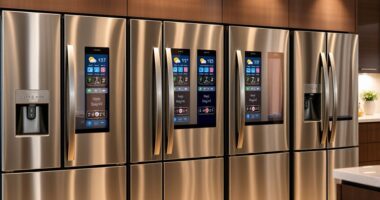If you’re looking to get started with easy home automation in 2025, I recommend exploring some of the top DIY smart home kits. These kits, like the KEYESTUDIO and GeekPii options, offer complete components, step-by-step guides, and support for platforms like Arduino and ESP32. They make setup simple, even for beginners, and cover various projects from IoT farming to security systems. Keep exploring, and you’ll discover which kit best fits your automation goals.
Key Takeaways
- Look for kits with comprehensive components, tutorials, and compatibility with popular microcontrollers like Arduino, ESP32, or micro:bit.
- Prioritize beginner-friendly features such as pre-assembled modules, clear instructions, and minimal wiring.
- Choose kits supporting remote control, automation, voice assistant integration (Alexa, Google Voice), and IoT connectivity.
- Consider versatility with sensors, actuators, and expansion options for various smart home automation projects.
- Evaluate compatibility with existing devices, open protocols, and future upgrade potential for seamless system integration.
KEYESTUDIO Smart Home Starter Kit for Arduino
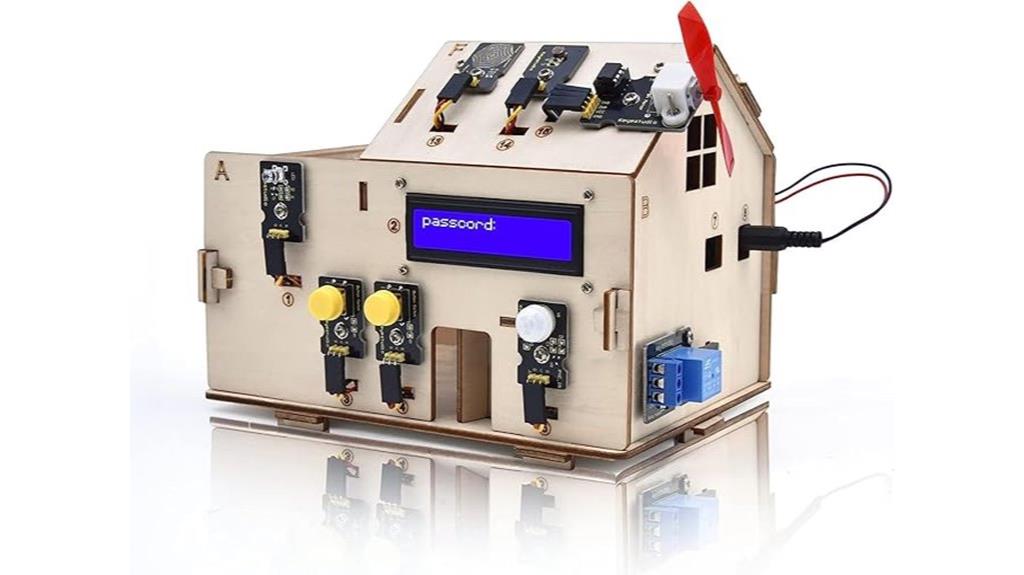
If you’re a beginner enthusiastic to explore home automation and electronics, the KEYESTUDIO Smart Home Starter Kit for Arduino is an ideal choice. It’s designed for newbies, teens, and adults enthusiastic to learn about DIY smart homes and programming. The kit includes instructions for 15 hands-on projects that cover essentials like sensors, LEDs, buttons, and actuators. With laser-cut wood model components, you can build a mini smart house that mimics real functions such as lighting, sensors, and Bluetooth control. All you need are a computer and batteries. Online tutorials make assembly and coding straightforward, making this kit perfect for practical learning and experimentation.
Best For: beginners, teens, and adults interested in learning home automation, electronics, and programming through hands-on projects with a smart home model.
Pros:
- Includes comprehensive instructions for 15 practical DIY projects to build foundational skills.
- Features a realistic, laser-cut wood model of a smart house with multiple sensors and automation functions.
- Compatible with Android and iOS devices for remote control, with online tutorials for easy assembly and coding.
Cons:
- Requires a computer and 6 AA batteries, which are not included, to operate the kit.
- As an entry-level kit, it may have limited advanced features for more experienced enthusiasts.
- Assembly and programming may take time for complete beginners to master.
KEYESTUDIO ESP32 Smart Home Starter Kit for Arduino and Python
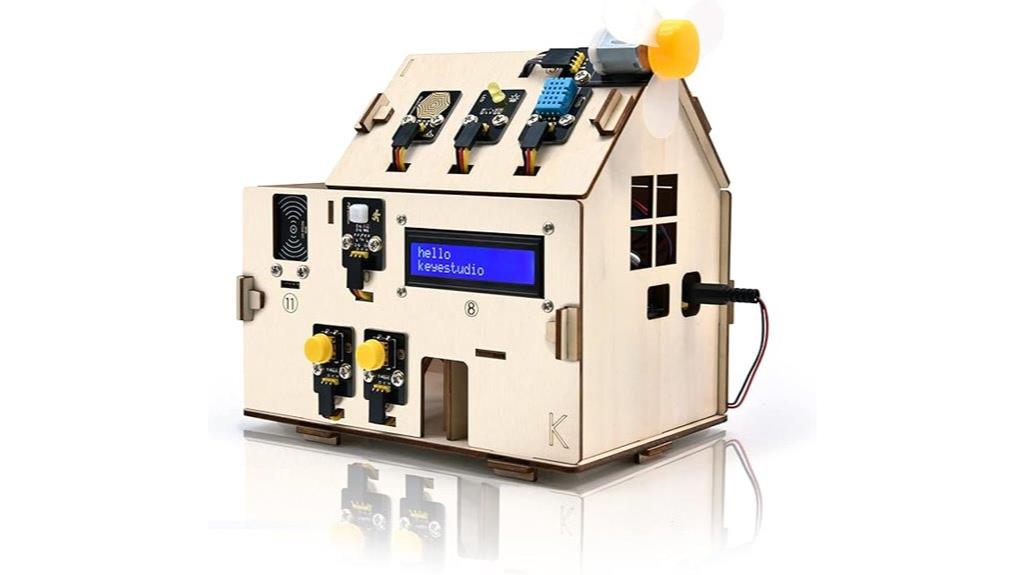
The KEYESTUDIO ESP32 Smart Home Starter Kit is an excellent choice for beginners and educators passionate to explore IoT, electronics, and home automation. It offers an all-inclusive platform with 13 hands-on projects, covering sensors, buttons, LEDs, and control of appliances via mobile phone. Powered by the ESP32 processor, it supports both Arduino and Python (MicroPython) programming, making it versatile for learning and experimentation. The kit includes a DIY wooden house model to visualize IoT concepts. While assembly and coding require some effort, the detailed tutorials help guide the process. It’s perfect for STEM education, hobbyists, and anyone enthusiastic to build smart home systems from scratch.
Best For: beginners, educators, and hobbyists interested in exploring IoT, home automation, and electronics using Arduino and Python.
Pros:
- Includes comprehensive tutorials and 13 hands-on projects for practical learning.
- Supports both Arduino and MicroPython, offering versatile programming options.
- Features a DIY wooden house model to visualize IoT concepts and enhance engagement.
Cons:
- Some users report issues with component quality, durability, and missing parts.
- Assembly and setup can be challenging for complete beginners due to limited wiring instructions.
- Software support and sample code may contain errors or be incompatible with certain libraries.
ELECFREAKS microbit Smart Home Kit (Without Micro:bit)

The ELECFREAKS microbit Smart Home Kit (Without Micro:bit) stands out as an excellent choice for beginners enthusiastic to explore home automation through hands-on projects. It offers a versatile set of sensors and modules, like temperature, sound, and crash sensors, along with actuators such as servos, motors, and rainbow LEDs, allowing you to create smart devices like voice-activated lights or automatic windows. Compatible with beginner-friendly Makecode programming, it promotes easy learning and experimentation. Without including the micro:bit itself, this kit provides flexibility to customize your projects while supporting educational resources and technical support, making it perfect for those starting their smart home automation journey.
Best For: beginners and students interested in learning home automation and electronics projects using micro:bit without prior experience.
Pros:
- Compatible with easy-to-use Makecode programming, ideal for beginners.
- Includes a variety of sensors and modules for versatile DIY smart home projects.
- Supports extensive educational resources and technical support to facilitate learning.
Cons:
- Does not include the micro:bit itself, requiring users to purchase it separately.
- Limited advanced features, making it less suitable for complex automation projects.
- Some users may find the overall kit packaging and instructions less comprehensive for more complex setups.
SpeedTalk Mobile GPS Tracker SIM Card Starter Kit
Designed for tech enthusiasts and DIYers seeking versatile tracking solutions, the SpeedTalk Mobile GPS Tracker SIM Card Starter Kit offers unmatched compatibility. It’s a 3-in-1 universal SIM card that fits standard, micro, and nano devices, making it suitable for a wide range of GPS trackers, IoT gadgets, pet trackers, security cameras, and more. The kit works nationwide in the U.S., connecting to SpeedTalk’s reliable network. Activation is simple and flexible—just purchase a plan, which is cancellable anytime, and you can port existing numbers or get new ones. With live support available seven days a week, this kit makes home automation and device tracking straightforward and accessible.
Best For: DIY tech enthusiasts and professionals seeking a versatile, compatible GPS tracking and IoT connectivity solution across multiple device types in the U.S. market.
Pros:
- Universal 3-in-1 SIM card compatible with standard, micro, and nano devices for broad device support.
- Flexible activation with no contracts, easy porting of existing numbers, and cancellable plans.
- Reliable nationwide coverage with live technical support available 7 days a week.
Cons:
- Customer ratings average only 3.3 out of 5 stars, indicating mixed reviews.
- Requires separate purchase of a service plan for activation.
- Limited information on data plans and pricing within the product description.
KEYESTUDIO IoT Control Smart Farm Starter Kit for Arduino ESP32
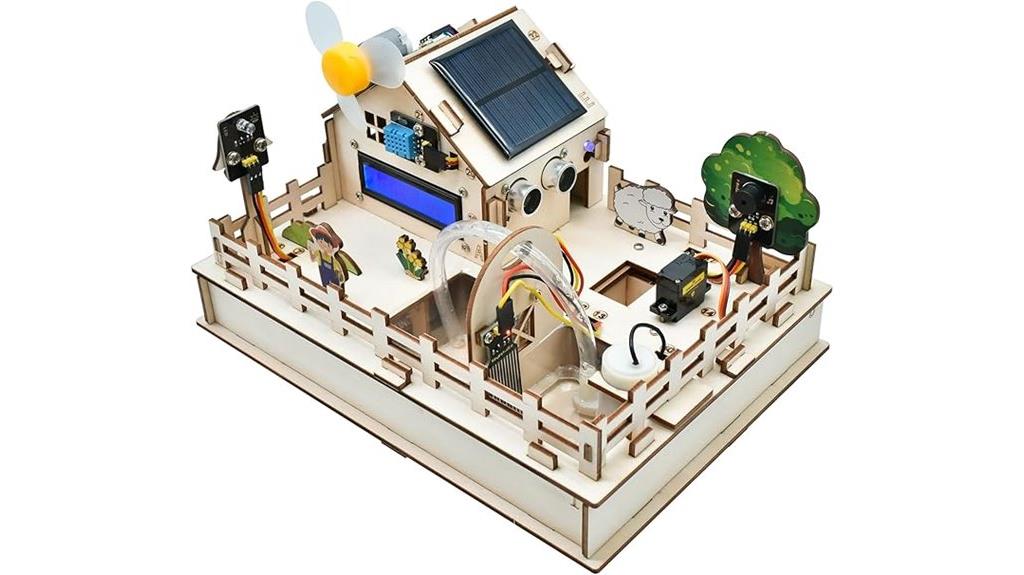
If you’re interested in combining IoT technology with agriculture, the KEYESTUDIO IoT Control Smart Farm Starter Kit for Arduino ESP32 is an excellent choice. It features the powerful ESP32 microcontroller with Wi-Fi, enabling wireless control and data collection. The kit includes sensors for soil moisture, water level, and light, making it perfect for automated farm management. Designed for teens and adults, it supports both Arduino and Scratch programming, offering flexibility for different skill levels. With extensive tutorials and open-ended project potential, this kit promotes hands-on learning and innovation in smart farming. It’s an engaging way to bring IoT into your agricultural projects.
Best For: hobbyists, educators, and DIY enthusiasts interested in exploring IoT applications in smart farming and agriculture projects.
Pros:
- Supports both Arduino and Scratch programming environments, offering flexibility for users of varying skill levels.
- Includes a variety of sensors such as soil moisture, water level, and light, enabling comprehensive farm automation.
- Comes with extensive online tutorials and project resources to facilitate hands-on learning and innovation.
Cons:
- The kit is unassembled and requires users to prepare batteries separately, which may be inconvenient for some.
- No pre-installed code or batteries included, potentially increasing setup time for beginners.
- Customer ratings are moderate (4.0/5), indicating some users may find the kit challenging or limited in features.
ELEGOO Mega R3 Arduino Starter Kit

For anyone looking to plunge into DIY smart home projects, the ELEGOO Mega R3 Arduino Starter Kit offers an excellent starting point with over 200 high-quality components centered around the powerful MEGA2560 microcontroller. This kit is perfect for both beginners and experienced makers, providing essential modules like an LCD1602 display and a GY-521 sensor with pre-installed headers—no soldering needed. It also includes LEDs, buttons, and ICs to expand your projects. Plus, a detailed PDF with over 35 lessons guides you through assembly and programming, making smart home automation accessible and straightforward. The organized packaging guarantees everything stays tidy and ready for use.
Best For: beginners and experienced makers interested in DIY smart home automation and microcontroller projects using a comprehensive Arduino starter kit.
Pros:
- Includes over 200 high-quality components for versatile project development
- Comes with pre-installed headers on modules like LCD1602 and GY-521 sensor, eliminating the need for soldering
- Detailed PDF tutorial with 35+ lessons enhances learning and project implementation
Cons:
- May be overwhelming for complete beginners due to the large number of components
- The extensive kit might be more than needed for simple projects, leading to potential storage challenges
- Limited information on advanced programming or custom hardware expansion beyond the included resources
3-in-1 ESP32 IoT Control Smart Factory Starter Kit

The in-1 ESP32 IoT Control Smart Factory Starter Kit stands out as an ideal choice for students and beginners enthusiastic to explore automation and IoT projects. It’s part of the STEM Smart Factory Education Series, featuring practical projects like smart robotic arms, conveyor lines, and warehouses. The kit helps users master programming, electronics, and innovative thinking through hands-on activities. With support for ACECode Blockly and Arduino IDE, it’s accessible for newcomers. All essential components are included, and detailed instructions make assembly straightforward. Perfect for teens 12+ and beginners, this kit promotes practical skills in automation, electronics, and system integration for real-world applications.
Best For: beginners, students, and hobbyists interested in learning about IoT, automation, and electronic system integration through hands-on projects.
Pros:
- Supports beginner-friendly programming environments like ACECode Blockly and Arduino IDE.
- Comprehensive set of electronic components and detailed instructions for easy assembly.
- Promotes practical skills in STEM, fostering creativity, problem-solving, and innovative thinking.
Cons:
- Batteries are not included, requiring users to purchase them separately.
- May require prior basic knowledge of electronics or programming for optimal learning.
- The complexity of projects might be challenging for absolute beginners without guidance.
OSOYOO IoT Smart Home Learner Kit for Arduino Mega2560
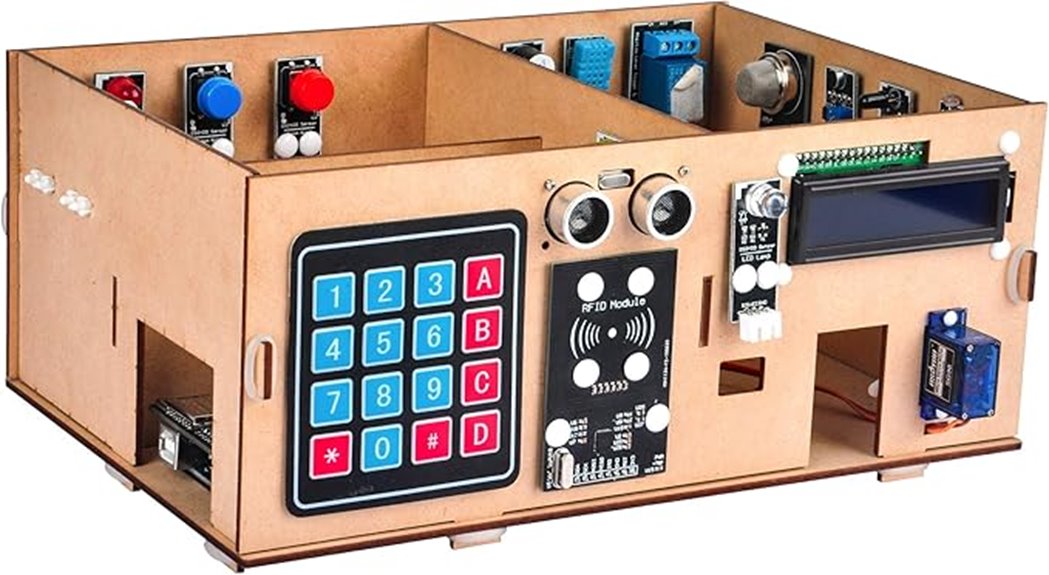
The OSOYOO IoT Smart Home Learner Kit for Arduino Mega2560 is an excellent choice for hobbyists and students enthusiastic to immerse themselves in practical IoT and home automation projects. It offers a thorough, hands-on learning experience with 19 lessons covering everything from basic programming to advanced smart home systems like RFID access, motion detection, and sensor integration. The kit includes essential hardware such as the Mega2560 board, IoT extension, relays, sensors, and modules, all designed for easy setup with error-free connections. Its focus on Wi-Fi connectivity and web-based control makes remote device management accessible, fostering skills in IoT programming and home automation.
Best For: hobbyists, students, and educators interested in hands-on learning and developing skills in IoT, electronics, and home automation projects using Arduino Mega2560.
Pros:
- Comprehensive 19-lesson curriculum covering from basic to advanced smart home applications
- Includes a wide range of hardware components for versatile project development
- Easy-to-setup error-free PnP connections facilitate quick learning and experimentation
Cons:
- May require some prior basic knowledge of electronics or programming for beginners
- Limited information on step-by-step troubleshooting within the kit’s documentation
- Wi-Fi connectivity setup can be complex for users unfamiliar with network configurations
YoLink Home Security Starter Kit with Wireless Sensors and Hub
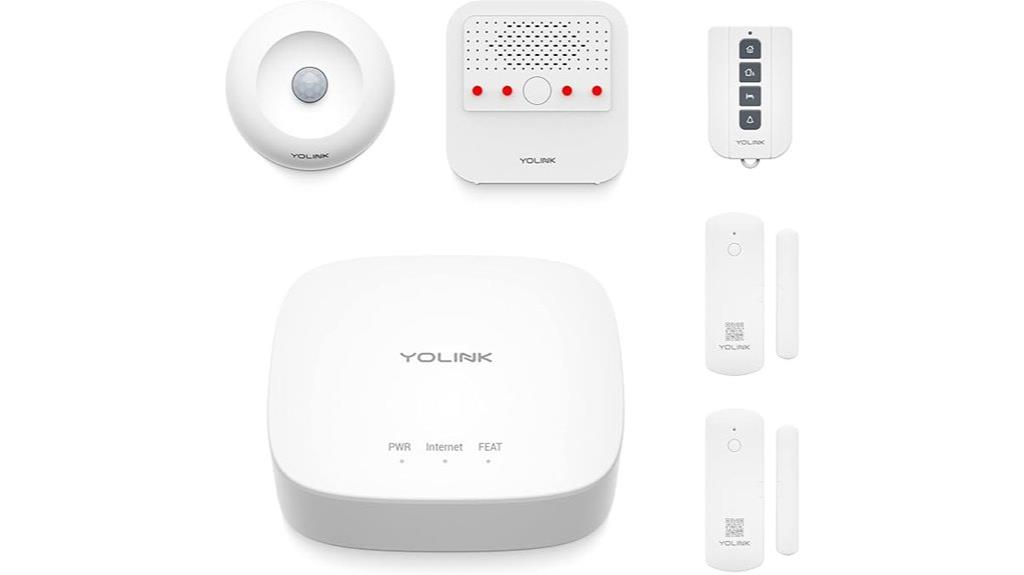
If you’re looking for a DIY home security solution that combines long-range connectivity with easy setup, the YoLink Home Security Starter Kit is an excellent choice. It includes a hub, indoor motion sensor, door/window sensors, a siren alarm, and a smart fob, providing thorough protection. Powered by LoRa technology, it offers an industry-leading ¼ mile wireless range, perfect for challenging areas like basements, sheds, or outdoor spaces. The system integrates seamlessly with Alexa and Google Voice, allowing voice control and automation. With reliable coverage and expandability options, it’s a simple, flexible way to enhance your home security effortlessly.
Best For: homeowners seeking a long-range, easy-to-install DIY security system that integrates with voice assistants and offers expandability.
Pros:
- Industry-leading ¼ mile LoRa wireless range ensures reliable coverage in challenging environments.
- Easy setup with comprehensive starter kit including sensors, siren, and smart fob.
- Seamless integration with Alexa and Google Voice for voice control and automation.
Cons:
- Requires compatible smart devices for full automation; may need additional products for advanced features.
- Subscription-based VirtuAlarm service for professional monitoring, which adds ongoing costs.
- Limited to the devices included in the starter kit unless expanded with additional YoLink products.
OSOYOO Robot RC Smart Car DIY Kit with Servo Power Steering, WiFi, Bluetooth, and Arduino Compatibility
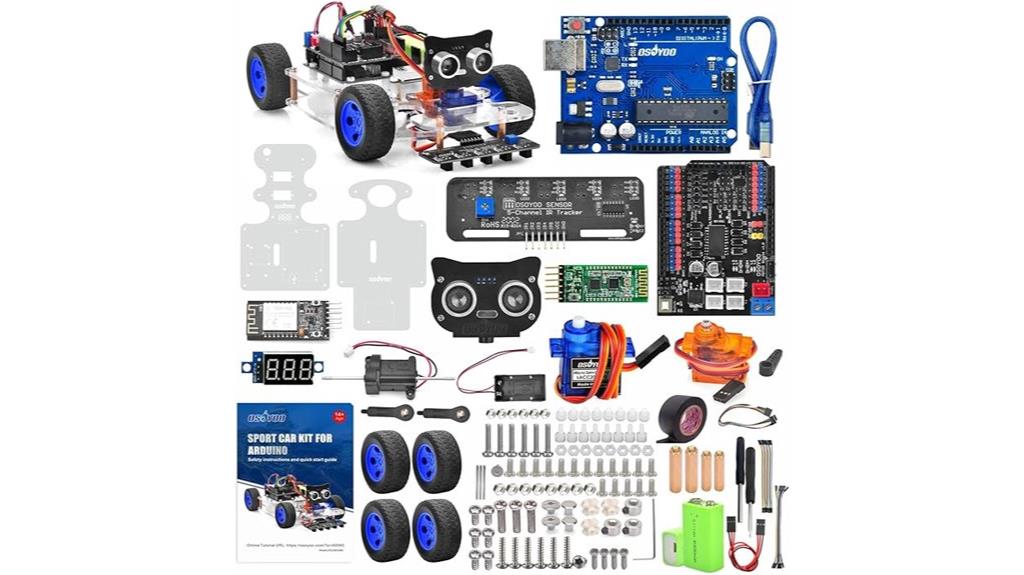
Anyone interested in learning robotics and programming will find the OSOYOO Robot RC Smart Car DIY Kit an excellent choice, especially because it combines advanced features like servo power steering, WiFi, and Bluetooth control. I love how it mimics real vehicles with electric power steering and offers functions like auto-go, line tracking, and ultrasonic avoidance. The kit supports Arduino programming and app control on Android and iOS devices, making it versatile and user-friendly. With all components included—motors, sensors, WiFi, and Bluetooth modules—it’s perfect for hands-on learning. Plus, the step-by-step instructions and tutorials make building and coding this smart car both accessible and rewarding.
Best For: robotics enthusiasts, students, and hobbyists looking for an educational and versatile DIY smart car kit with advanced features and easy programming options.
Pros:
- Supports Arduino programming and app control on Android and iOS devices for flexible operation.
- Includes comprehensive components such as WiFi, Bluetooth, sensors, and motors for a complete building experience.
- Facilitates hands-on learning in electronics, programming, and mechanical engineering with detailed tutorials and instructions.
Cons:
- Requires some basic knowledge of electronics and programming for optimal use.
- May be challenging for complete beginners without prior experience in robotics.
- Limited advanced features may not satisfy users seeking high-end or autonomous robotics capabilities.
OSOYOO Smart House IoT Starter Kit for Arduino MEGA2560
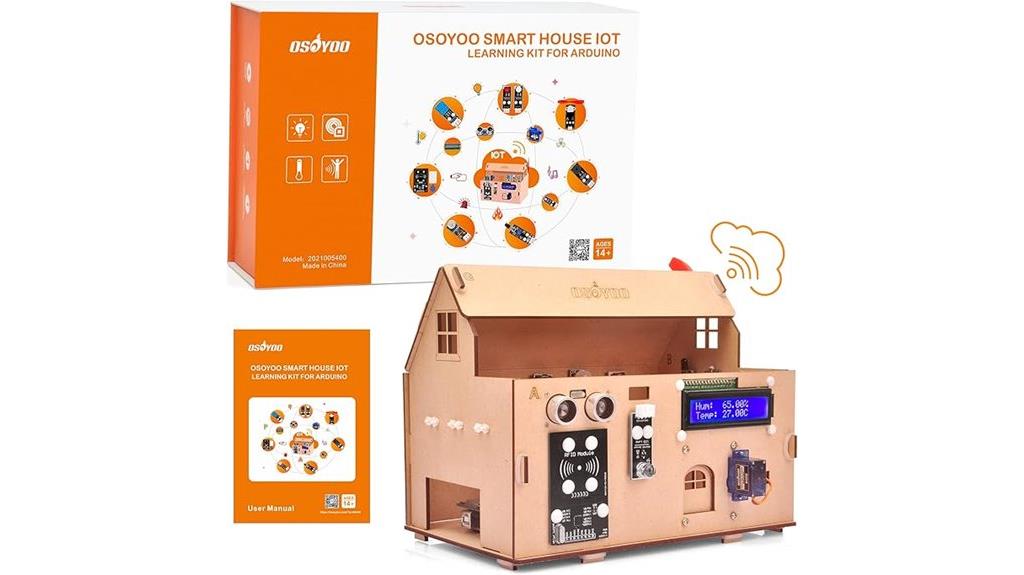
Owners and educators seeking an accessible, all-in-one solution will find the OSOYOO Smart House IoT Starter Kit for Arduino MEGA2560 an excellent choice. This kit offers a comprehensive set of components, including a wooden house model, sensors, actuators, and the powerful MEGA2560 board with Wi-Fi extension. It’s perfect for beginners and students, providing detailed tutorials on assembly, coding, and automation. With the ability to control devices remotely via the OSOYOO IoT app, it offers practical experience in home automation. Whether for STEM education, self-study, or workshops, this kit makes learning electronics and programming engaging and straightforward.
Best For: educators, students, and hobbyists interested in hands-on learning of electronics, coding, and IoT home automation projects using a comprehensive, beginner-friendly kit.
Pros:
- All-in-one kit with extensive components and detailed tutorials, ideal for beginners.
- Supports remote device control through the OSOYOO IoT App, enhancing practical experience.
- Promotes STEM education and self-study with easy setup and clear instructions.
Cons:
- May require additional components or peripherals for more advanced projects.
- Limited compatibility outside of Arduino MEGA2560 ecosystem.
- Some users might find the Wi-Fi connection setup challenging initially.
WhalesBot D1 21-in-1 STEM Coding Robot Kit for Kids
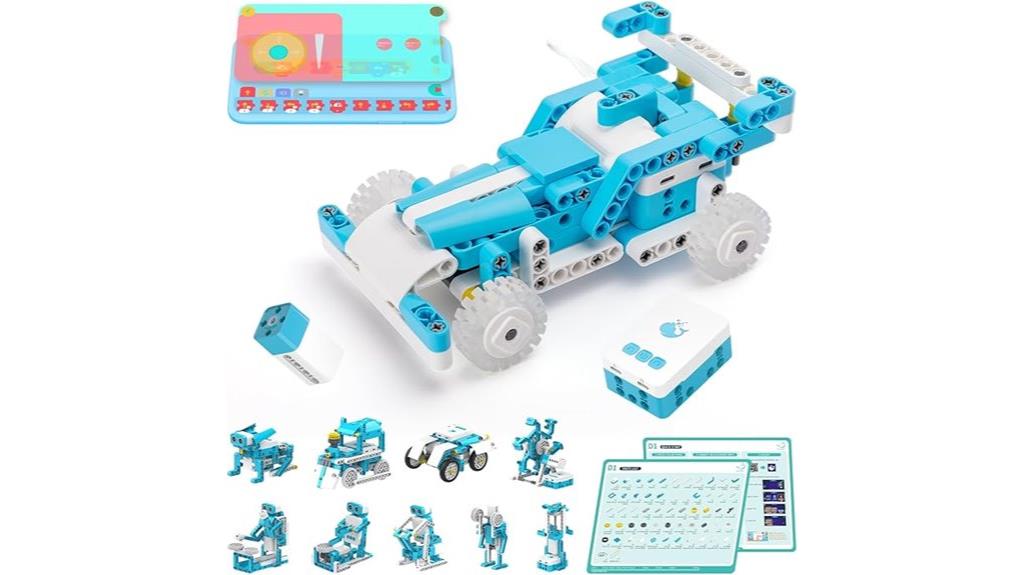
The WhalesBot D1 21-in-1 STEM Coding Robot Kit for Kids is an excellent choice for young children aged 4 to 10 who want to immerse themselves in hands-on robotics and coding. With over 280 parts, it combines building, remote control, and modular coding into one engaging set. Kids can build their robot, connect via Bluetooth, and use an app to control movements, sounds, and more. The kit offers guided challenges and creative modes, encouraging exploration and confidence. Suitable for home or school, it helps children develop problem-solving, logic, and tech skills through fun, interactive activities tailored to their age.
Best For: young children aged 4 to 10 who want to learn robotics and coding through hands-on building and interactive play.
Pros:
- Offers over 280 parts for diverse building options and creativity
- Combines building, remote control, and modular coding into one educational set
- Supports guided challenges and creative modes to foster exploration and confidence
Cons:
- Requires 3 AA batteries for the smart controller (not included)
- May need adult supervision for younger children during setup and building
- Limited to Bluetooth connectivity, which might pose pairing issues on some devices
GeeekPi Arduino UNO R4 WiFi Starter Kit with 78 Components

The GeeekPi Arduino UNO R4 WiFi Starter Kit stands out as an excellent choice for beginners and engineers alike, thanks to its all-encompassing set of 78 components that simplify learning and development. It includes the UNO R4 WiFi board with a powerful 32-bit RA4M1 microcontroller and an ESP32 module for Wi-Fi and Bluetooth connectivity, making it perfect for creating connected projects. The kit also features tutorials that guide you through programming and setup, making it easy to start experimenting. With a 12×8 LED matrix and a variety of electronic parts, this kit supports numerous projects, whether you’re learning or prototyping your smart home automation ideas.
Best For: beginners, students, and engineers seeking an all-in-one starter kit for learning, prototyping, and developing connected electronic projects.
Pros:
- Includes 78 components, providing a comprehensive set for diverse projects
- Equipped with a powerful 32-bit RA4M1 microcontroller and ESP32 module for Wi-Fi and Bluetooth connectivity
- Comes with tutorials that facilitate easy setup and learning
Cons:
- Might be overwhelming for absolute beginners due to the number of components
- The complexity of projects may require additional resources or experience
- Limited details on the compatibility of all components with various development environments
GeeekPi Cloud Starter Kit with UNO R4 for IoT and LED Matrix
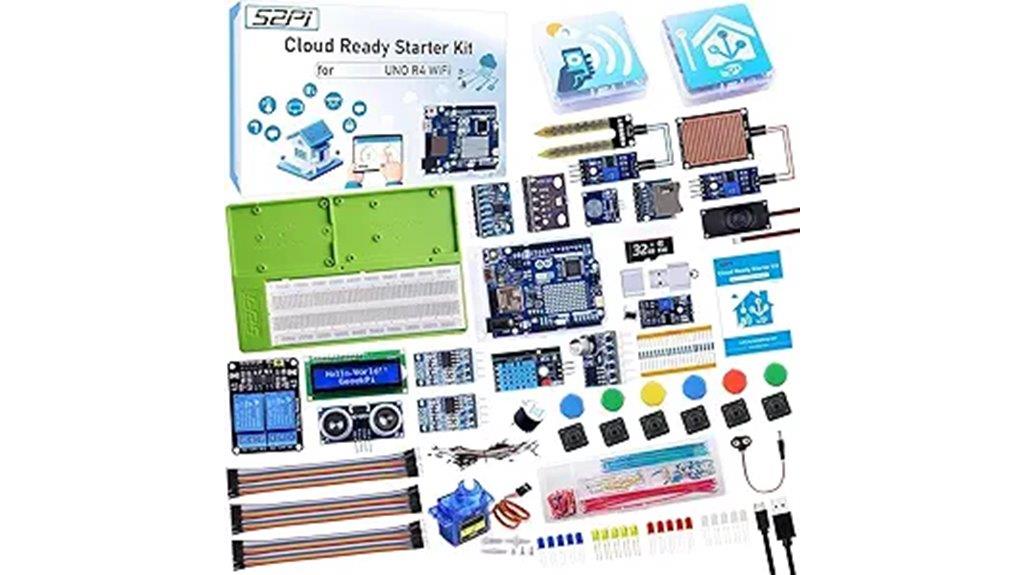
If you’re looking to jump into IoT projects with a focus on smart home automation, the GeeekPi Cloud Starter Kit with UNO R4 for IoT and LED Matrix is an excellent choice. It features the UNO R4 Wi-Fi board with built-in wireless capabilities, enabling remote monitoring, data logging, and real-time control. The kit includes sensors for temperature, humidity, and motion detection, perfect for environmental monitoring. With all-encompassing tutorials designed for beginners and engineers alike, you can easily learn and customize your projects. The 12×8 LED matrix adds visual feedback, making it ideal for home automation displays. Overall, it’s a versatile kit that simplifies IoT integration for smart home enthusiasts.
Best For: hobbyists, educators, and engineers interested in IoT, smart home automation, and hands-on electronics projects.
Pros:
- Includes a versatile UNO R4 Wi-Fi board with built-in wireless connectivity for easy IoT integration
- Comes with comprehensive tutorials suitable for beginners and advanced users to learn and customize projects
- Features a 12×8 LED matrix for visual feedback and real-time display capabilities
Cons:
- Relatively larger and heavier, which may limit portability for some applications
- Requires familiarity with electronics and programming for optimal use, potentially challenging for complete beginners
- Limited details on sensor accuracy and long-term durability in the product description
GAR Arduino Starter Kit with Sensor Modules and WiFi/Bluetooth for STEM Projects

For anyone enthusiastic to plunge into STEM projects or develop their own smart home systems, the GAR Arduino Starter Kit with Sensor Modules and WiFi/Bluetooth offers an ideal starting point. It features over 65 pieces, including multiple Arduino boards like Uno R3, Mega 2560, Nano V3, ESP32, and ESP8266, all in a durable organizer. The kit includes a wide variety of sensors, modules, motors, and wireless transceivers, allowing for diverse automation and IoT projects. With extensive documentation, tutorials, and support from a US-based team, it’s perfect for beginners and experts alike. Plus, its high-quality components and extensive resources ensure a smooth, enriching learning experience.
Best For: beginners and experienced hobbyists eager to dive into STEM, IoT, and smart home projects with a comprehensive, high-quality Arduino starter kit.
Pros:
- Includes a wide variety of sensors, modules, and multiple Arduino boards to support diverse projects
- Comes with extensive documentation, tutorials, and lifetime support for a smooth learning curve
- High-quality components from reputable manufacturers, all stored in a durable organizer
Cons:
- Higher price point compared to basic starter kits due to extensive features and resources
- Some modules may require soldering or minor adjustments, which could be challenging for absolute beginners
- A few components like jumper wires may be missing initially but are quickly supplied by the seller
Factors to Consider When Choosing DIY Smart Home Starter Kits

When choosing a DIY smart home starter kit, I look at how well it works with my existing devices and how easy it is to set up. I also consider the programming languages it supports, the range of sensors and modules available, and what power sources it needs. These factors help me pick a kit that’s reliable, flexible, and simple to use.
Compatibility With Devices
Choosing a DIY smart home starter kit requires guaranteeing that it seamlessly works with your existing devices and systems. First, check if it supports your device’s operating system—whether iOS, Android, Windows, or macOS—for smooth control and programming. Next, verify that the kit’s hub or controller is compatible with common wireless protocols like Wi-Fi, Bluetooth, Zigbee, or Z-Wave, so it integrates well with your current ecosystem. Also, confirm that sensors, actuators, and modules can connect with your preferred voice assistants, such as Alexa, Google Assistant, or Siri, for effortless voice control. Finally, ensure compatibility with existing smart devices and platforms, ideally through open APIs or protocols, to keep your system flexible and future-proof.
Ease of Assembly
The ease of assembly plays a essential role in selecting a DIY smart home starter kit, especially if you’re new to home automation. Some kits are simple, with pre-assembled modules and minimal wiring, making setup straightforward. Others may require detailed connections or soldering, which can be intimidating for beginners. Clear, step-by-step instructions or online tutorials are critical to avoid mistakes and speed up the process. Kits featuring modular components, snap-on parts, or plug-and-play designs greatly simplify assembly. Labeled parts and color-coded wiring also help you identify connections quickly, reducing confusion. Additionally, pre-assembled or partially assembled kits cut down setup time and technical challenges, making it easier for newcomers to enjoy their smart home experience without frustration.
Programming Language Options
Selecting a DIY smart home starter kit involves considering the programming language options it supports, as this can greatly influence your learning curve and future capabilities. I look for kits that support popular languages like C, MicroPython, or offer graphical block-based coding, making it easier to match my current skill level. Having multiple language options is ideal, as it allows me to start simple and progress to more advanced scripts over time. I also check if the programming environment provides clear tutorials and documentation to help me learn efficiently. Compatibility with my existing devices and development platforms is essential for seamless integration. Additionally, I consider whether the kit supports remote control, automation scripting, and IoT protocols, broadening my home automation possibilities as I grow more confident.
Sensor and Module Range
Since sensors are the eyes and ears of a smart home system, I pay close attention to their range and capabilities to guarantee reliable automation. I look for kits that include a variety of sensors—temperature, humidity, motion, light, and gas—to cover all my needs. It’s crucial that modules support communication protocols like Wi-Fi, Bluetooth, or Zigbee for smooth integration with other devices. I also check sensor specifications such as accuracy, response time, and operating range to ensure consistent performance in my home environment. Additionally, I verify that the modules come with detailed documentation and tutorials, making setup and troubleshooting easier. Lastly, I consider the system’s expandability, so I can add or upgrade sensors as my smart home evolves.
Power Supply Requirements
Choosing the right power supply for your DIY smart home kit is vital to guarantee reliable and safe operation. First, check the kit’s specifications for the type and number of batteries needed, like 6 AA batteries, to confirm compatibility. Determine if the power source is built-in or requires external adapters, especially for high-power components. Flexibility is key, so see if the kit supports USB power or can run from a computer or mobile power bank for portability. Pay attention to voltage and current requirements to avoid damaging components or causing insufficient power during operation. Additionally, verify if the kit includes a power regulation module, which helps maintain stable voltage levels, maintaining safety and consistent performance.
Expansion and Upgrade Potential
When evaluating a DIY smart home starter kit, it’s important to take into account how well it can grow and adapt to your evolving needs. I look for kits that support adding new sensors, actuators, or modules so I can expand functionalities over time. Compatibility with popular protocols like Wi-Fi, Zigbee, or Z-Wave ensures I can seamlessly integrate additional devices. I also check if there are compatible accessories or expansion boards available for upgrades. The software ecosystem should allow easy firmware updates, customization, and new feature integration. Lastly, comprehensive documentation and active community support are vital—they make troubleshooting easier and help guarantee my system can evolve smoothly with minimal hassle.
Support and Documentation Quality
How important is support and documentation when selecting a DIY smart home starter kit? It’s vital because high-quality support and detailed documentation make troubleshooting much easier and increase your chances of success. Well-structured tutorials, wiring diagrams, and step-by-step guides help beginners grasp complex concepts without frustration. Access to online communities, forums, or direct customer service provides quick assistance and valuable tips, saving you time and stress. Clear, current documentation minimizes errors caused by outdated info or ambiguous instructions, ensuring smoother setup. Responsive support builds confidence, making the DIY experience more enjoyable and less intimidating. Ultimately, strong support and extensive documentation empower you to complete your project confidently and efficiently, turning a complicated task into an achievable, rewarding home automation upgrade.
Price and Budget Considerations
Evaluating your budget early on is essential because DIY smart home starter kits come in a wide price range, from under $50 to over $300. It’s important to take into account the total cost, including accessories, sensors, and potential subscription fees for app services or cloud storage. Balancing your spending with the features you need helps you avoid paying for unnecessary extras. Look for value packs or bundles that include multiple sensors and controllers to maximize functionality while keeping costs down. Keep in mind that higher-priced kits often offer better build quality and more comprehensive support, which can save money in the long run through durability and assistance. Setting a clear budget helps you choose a kit that offers the best value without overspending.
Frequently Asked Questions
Which Starter Kit Is Best for Complete Beginners?
If you’re a complete beginner, I recommend starting with the Wyze Smart Home Starter Kit. It’s user-friendly, affordable, and includes everything you need to get started with basic automation. I found it straightforward to set up, with a simple app interface that guides you through each step. This kit helps you dip your toes into smart home tech without feeling overwhelmed, making it perfect for beginners like you.
How Compatible Are These Kits With Voice Assistants?
Think of these kits as your own personal Jarvis—most are highly compatible with voice assistants like Alexa, Google Assistant, and Siri. I’ve found that many include built-in support or easy integration options, making voice control a breeze. Just verify your chosen kit mentions compatibility upfront; most are designed to work seamlessly with popular voice platforms, giving you effortless control over your smart home with just your voice.
Can These Kits Be Expanded With Additional Components?
Yes, these kits can be expanded with additional components. I love that many are designed with modularity in mind, allowing me to add smart bulbs, sensors, or switches as needed. It’s pretty straightforward to integrate new devices because most kits support popular protocols like Zigbee or Z-Wave. So, whether I want to upgrade or customize my setup, I find these kits flexible and easy to grow over time.
Do These Kits Require Prior Coding Experience?
Think of these kits like a simple recipe—you don’t need to be a chef to get started. Most of them don’t require any prior coding experience; they’re designed for beginners. You can set up your smart home with basic tools and step-by-step instructions. If you do want to customize things further, some light coding might help, but it’s not a must-have to enjoy your new automation.
Are These Kits Suitable for Outdoor Smart Home Projects?
Yes, some of these kits are suitable for outdoor projects. I recommend checking each kit’s specifications, as many include weatherproof devices designed to withstand the elements. I’ve found that kits with outdoor-compatible cameras, sensors, and smart lighting are perfect for creating a secure and functional outdoor space. Just make sure to choose one that explicitly states it’s weather-resistant, so your setup stays reliable regardless of the weather.
Conclusion
Did you know that over 60% of homeowners plan to upgrade to smart home tech in the next year? Choosing the right DIY starter kit can be overwhelming, but it’s worth it for the convenience and control it offers. Whether you’re into Arduino, micro:bit, or IoT projects, there’s a kit for you. Start small, learn as you go, and enjoy transforming your home into a smarter, more connected space.





